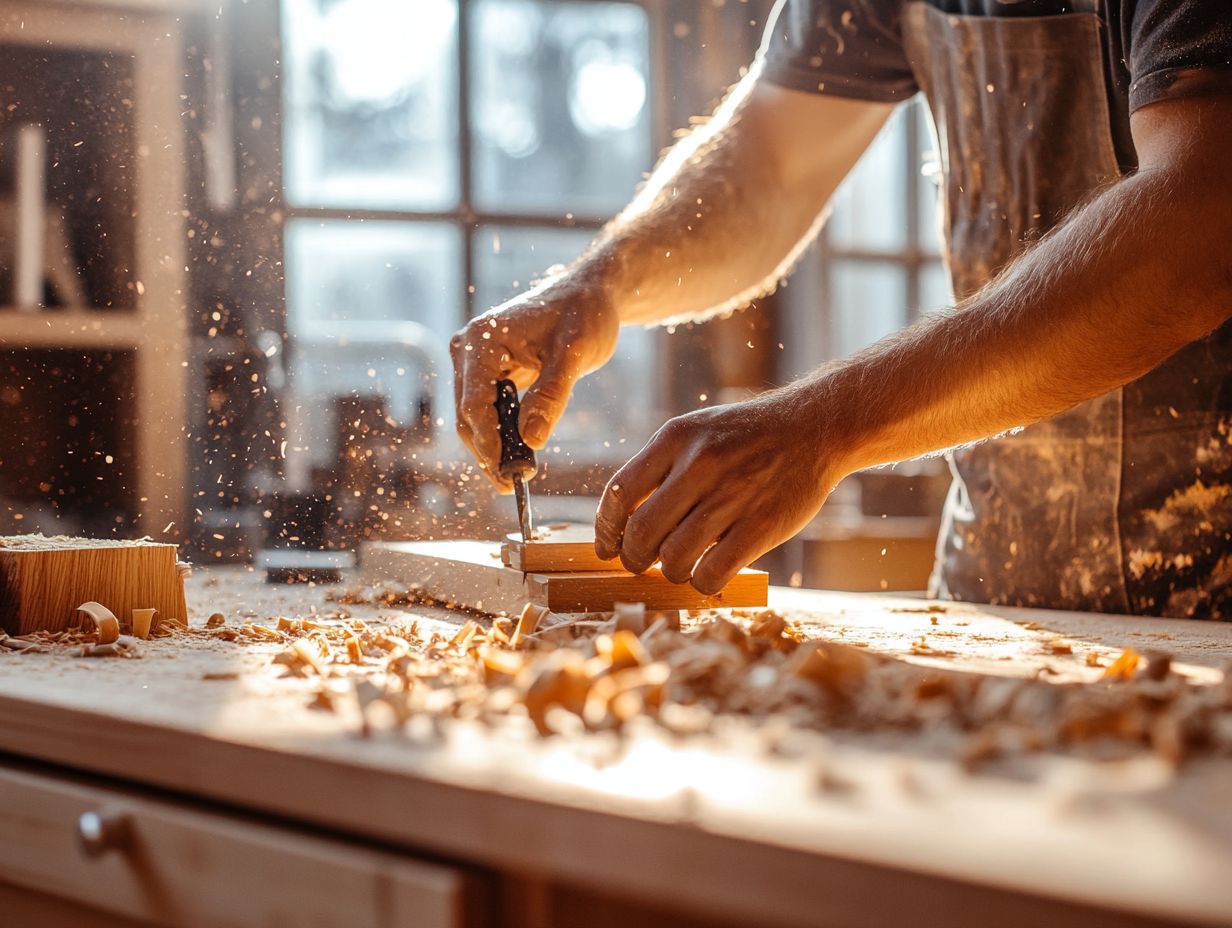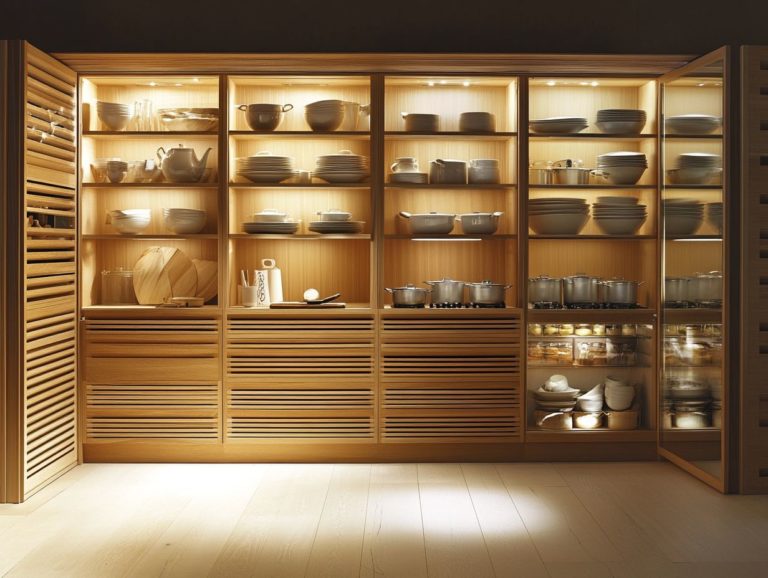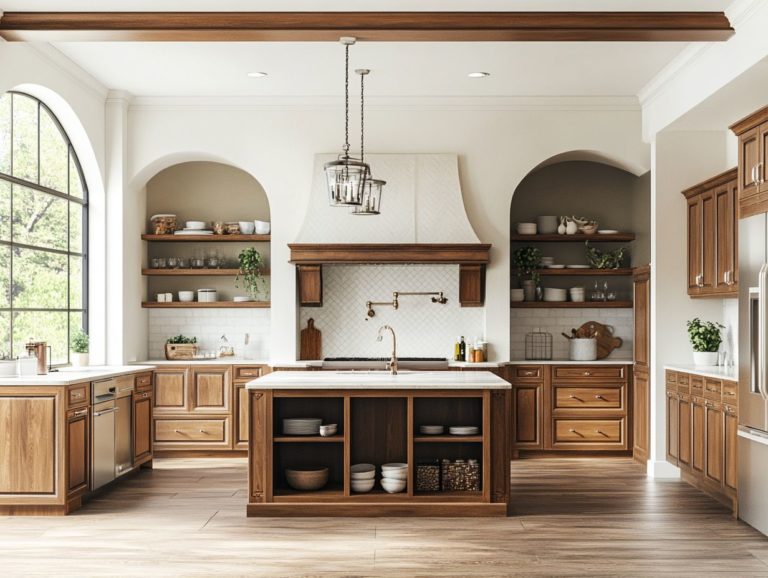DIY: How to Build Your Own Kitchen Cabinets
Building your own kitchen cabinets is a rewarding and cost-effective way to elevate your space.
This guide will take you through the journey, from gathering essential tools and materials to crafting beautiful cabinets that reflect your style.
Discover step-by-step techniques for design, construction, and finishing, along with expert tips for a polished, professional look.
You will also learn how to maintain your DIY cabinets, ensuring they remain stunning for years to come.
Get ready to dive into this exciting creative journey!
Contents
- Key Takeaways:
- Benefits of Building Your Own Cabinets
- Tools and Materials Needed
- Step-by-Step Guide to Building Kitchen Cabinets
- Maintenance and Care for DIY Cabinets
- Frequently Asked Questions
- Can anyone build their own kitchen cabinets?
- What tools will I need for this project?
- How much time does it take to build kitchen cabinets?
- What materials should I use for my cabinets?
- Do I need to have a detailed plan before starting the project?
- What are some common mistakes to avoid when building kitchen cabinets?
Key Takeaways:
- Save money and customize your kitchen by building your own cabinets.
- Essential tools and materials include a saw, drill, and quality wood.
- Key steps for successful cabinet construction are design and planning, building the frame, and installing doors and drawers.

Benefits of Building Your Own Cabinets
Crafting your own cabinets offers numerous advantages. It allows you to tailor designs to your tastes, optimize storage, and save money compared to buying pre-fabricated options.
By leveraging your woodworking skills, you can design unique pieces that fit seamlessly into your kitchen, enhancing its aesthetic appeal.
This DIY approach gives you control over materials, ensuring high-quality components that align with your needs.
Not only does this hands-on endeavor spark creativity, but it also provides personal satisfaction, making it an excellent project for both beginners and experienced woodworkers.
Tools and Materials Needed
Selecting the right tools and materials is crucial for successful cabinet building. This ensures a professional finish while maintaining efficiency.
Key woodworking tools you’ll want include:
- A table saw for precise cuts.
- A tool that helps join pieces of wood together securely.
- Construction screws for durable assembly.
Plywood sheets and wood glue are essential for crafting sturdy cabinet boxes and adjustable shelves. Face boards and cabinet pulls enhance your overall cabinet design and functionality.
By equipping yourself with the right resources, you can simplify construction techniques and elevate the quality of your finished project.
Essential Tools and Materials
The tools and materials for building cabinets include woodworking tools, plywood sheets, construction screws, and quality wood glue—each plays a pivotal role in ensuring robust construction.
Woodworking tools, like saws and drills, help achieve precision cuts, making assembly easier. Plywood sheets provide a sturdy yet lightweight structure for your cabinets.
Construction screws firmly join parts together and enhance stability, while quality wood glue adds an extra layer of bond for longevity.
Thoughtfully choosing and using these essential tools and materials lets you create cabinets that fulfill functional needs and boast an aesthetically pleasing finish.
Step-by-Step Guide to Building Kitchen Cabinets
Creating your own DIY kitchen cabinets can be incredibly rewarding. By following a detailed guide, you can navigate the process confidently, from design to installation.
Begin by planning your cabinet dimensions and styles, considering how your storage solutions connect with your kitchen layout.
Next, use your woodworking skills to construct the cabinet frame and assemble the boxes with precision.
Finally, focus on installation, ensuring everything is aligned and securely in place for durability and functionality.
With this approach, you’ll complete your home improvement project with a professional touch.
Start your cabinet-building project today and enjoy the process!
Design and Planning

Design and planning are crucial stages in crafting your DIY kitchen cabinets. Here, you’ll determine the cabinet dimensions, styles, and overall aesthetic to bring your interior design vision to life.
Taking the time to carefully measure your available space ensures your cabinets fit flawlessly. This enhances both functionality and flow within the kitchen.
Selecting the right cabinet styles, like shaker style, adds character and complements a variety of decors. Choosing colors that harmonize with your existing kitchen palette can transform the area into a cohesive and inviting space.
This careful planning will instantly boost your kitchen’s charm and functionality, making every culinary endeavor a delightful experience.
Building the Frame
Building the frame of your cabinets is an essential step that demands precision and strong woodworking skills. This ensures both stability and durability.
To achieve a well-constructed cabinet frame, never underestimate the importance of incorporating vertical supports. These elements provide the essential strength and stability your entire structure needs.
Accurate measurements are paramount at every stage. Even a slight miscalculation can result in misalignment and structural weaknesses.
Using various construction techniques like pocket hole joinery and dado cuts can enhance the integrity of the frame while making assembly easier.
Using high-quality materials and ensuring all joints are securely fastened will contribute to a long-lasting outcome. Don’t miss these helpful tips: pre-drilling holes and using clamps can make everything run smoother and more efficiently.
Installing Doors and Drawers
Installing doors and drawers is a crucial aspect of the cabinet building process. It transforms your cabinet from a mere structure into a functional and visually appealing centerpiece in your kitchen.
By following a series of steps, you can achieve a professional-looking finish. Start by measuring the cabinet frame to ensure that the doors and drawers align perfectly, enhancing usability and aesthetics.
Next, pay close attention to the placement of cabinet pulls; their positioning greatly impacts ease of access and style. The height at which you install these components is vital for comfort, especially if you access the cabinets frequently.
Each of these steps is essential to ensure your cabinet area not only functions seamlessly but also integrates harmoniously into your overall design.
Tips and Tricks for a Professional Finish
Achieving a professional finish in your DIY cabinets can elevate the overall aesthetic of your kitchen. Here are some tips and tricks to enhance your painting and staining techniques, allowing you to transform your space with finesse and style:
Painting and Staining Techniques
Using the right painting and staining techniques can significantly enhance the visual appeal of your DIY cabinets. You can infuse nature-inspired colors that truly express your personal style.
To achieve stunning results, select colors that harmonize with your home’s decor and overall mood. Techniques like layering, glazing, and distressing can create one-of-a-kind finishes that add depth and character.
Consider how different cabinet materials will interact with various paints and stains. For instance, a rich oak can provide warmth when paired with darker hues, while lighter materials might be perfect for vibrant pastels.
Experimenting with matte versus glossy finishes can also dramatically influence the final look, enhancing the innate beauty of the textures you’re working with.
Installing Hardware

Installing hardware like cabinet pulls is the final touch that breathes life into your DIY kitchen cabinets. This enhancement boosts both usability and aesthetic appeal. Choosing the right hardware is crucial; it should complement your space’s overall design while ensuring ease of use.
A carefully planned installation process can significantly elevate your cabinet storage solutions.
- Start by selecting pulls that match the style and finish of your cabinets, considering factors such as size and material.
- Next, measure the appropriate height for installation. This ensures the handles are comfortable to grip.
- Mark the desired location, drill small pilot holes to guide the screws, and then secure the pulls with the provided screws.
Following this approach streamlines your project and guarantees that each element integrates seamlessly. This creates a cohesive look that is stylish and practical.
Maintenance and Care for DIY Cabinets
Proper maintenance and care for your DIY cabinets are crucial for preserving their beauty and functionality over time. By attending to them regularly, you ensure they remain a vital part of your kitchen environment.
Troubleshooting Common Issues
Troubleshooting common issues with DIY cabinets can be a game-changer! Don’t fret! You can fix common issues easily, saving you time and keeping your cabinetry functional and visually appealing.
Common problems include misalignment, where doors and drawers refuse to line up properly, creating a less-than-polished look. Door sagging is another frequent issue, usually resulting from improper hinge installation or uneven weight distribution. If the slides aren’t mounted correctly, you might face frustrating experiences with sticking or jamming drawers.
Addressing these issues quickly keeps your kitchen looking its best! It’s essential to invest in high-quality cabinet materials and adhere to proper installation techniques. Opting for premium hardware enhances durability and significantly improves performance, making these solutions both practical and vital for your long-term satisfaction.
Watch this video for tips on DIY cabinet installation!
Frequently Asked Questions
Here are some common questions to help you on your cabinet-building journey.
Can anyone build their own kitchen cabinets?
Yes, anyone with basic carpentry skills and the right tools can build their own kitchen cabinets.
What tools will I need for this project?

You will need a tape measure, saw, drill, screwdriver, clamps, and a level, among other basic tools. A table saw and miter saw are also recommended for more precise cuts.
How much time does it take to build kitchen cabinets?
The time required to build kitchen cabinets depends on the complexity of the design and your level of experience. On average, it can take anywhere from 2-4 days to build a set of cabinets.
What materials should I use for my cabinets?
The most common and cost-effective options for kitchen cabinets are plywood and solid wood for the frame and doors. You can also use MDF or particle board for a more budget-friendly choice.
Do I need to have a detailed plan before starting the project?
Yes, it is essential to have a detailed plan and measurements in place before starting the project. This ensures that everything fits together properly. Many free plans and tutorials are available online for building kitchen cabinets.
What are some common mistakes to avoid when building kitchen cabinets?
Common mistakes to avoid include inaccurate measuring, neglecting safety precautions, using the wrong tools, and failing to sand and finish the cabinets properly. Having a solid plan in place before starting is also essential.





